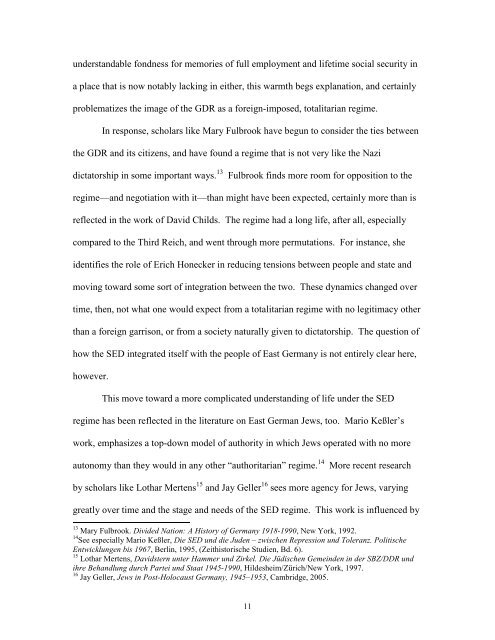Jews in Leipzig - The University of Texas at Austin
Jews in Leipzig - The University of Texas at Austin
Jews in Leipzig - The University of Texas at Austin
Create successful ePaper yourself
Turn your PDF publications into a flip-book with our unique Google optimized e-Paper software.
understandable fondness for memories <strong>of</strong> full employment and lifetime social security <strong>in</strong><br />
a place th<strong>at</strong> is now notably lack<strong>in</strong>g <strong>in</strong> either, this warmth begs explan<strong>at</strong>ion, and certa<strong>in</strong>ly<br />
problem<strong>at</strong>izes the image <strong>of</strong> the GDR as a foreign-imposed, totalitarian regime.<br />
In response, scholars like Mary Fulbrook have begun to consider the ties between<br />
the GDR and its citizens, and have found a regime th<strong>at</strong> is not very like the Nazi<br />
dict<strong>at</strong>orship <strong>in</strong> some important ways. 13 Fulbrook f<strong>in</strong>ds more room for opposition to the<br />
regime—and negoti<strong>at</strong>ion with it—than might have been expected, certa<strong>in</strong>ly more than is<br />
reflected <strong>in</strong> the work <strong>of</strong> David Childs. <strong>The</strong> regime had a long life, after all, especially<br />
compared to the Third Reich, and went through more permut<strong>at</strong>ions. For <strong>in</strong>stance, she<br />
identifies the role <strong>of</strong> Erich Honecker <strong>in</strong> reduc<strong>in</strong>g tensions between people and st<strong>at</strong>e and<br />
mov<strong>in</strong>g toward some sort <strong>of</strong> <strong>in</strong>tegr<strong>at</strong>ion between the two. <strong>The</strong>se dynamics changed over<br />
time, then, not wh<strong>at</strong> one would expect from a totalitarian regime with no legitimacy other<br />
than a foreign garrison, or from a society n<strong>at</strong>urally given to dict<strong>at</strong>orship. <strong>The</strong> question <strong>of</strong><br />
how the SED <strong>in</strong>tegr<strong>at</strong>ed itself with the people <strong>of</strong> East Germany is not entirely clear here,<br />
however.<br />
This move toward a more complic<strong>at</strong>ed understand<strong>in</strong>g <strong>of</strong> life under the SED<br />
regime has been reflected <strong>in</strong> the liter<strong>at</strong>ure on East German <strong>Jews</strong>, too. Mario Keßler’s<br />
work, emphasizes a top-down model <strong>of</strong> authority <strong>in</strong> which <strong>Jews</strong> oper<strong>at</strong>ed with no more<br />
autonomy than they would <strong>in</strong> any other “authoritarian” regime. 14 More recent research<br />
by scholars like Lothar Mertens 15 and Jay Geller 16 sees more agency for <strong>Jews</strong>, vary<strong>in</strong>g<br />
gre<strong>at</strong>ly over time and the stage and needs <strong>of</strong> the SED regime. This work is <strong>in</strong>fluenced by<br />
13 Mary Fulbrook. Divided N<strong>at</strong>ion: A History <strong>of</strong> Germany 1918-1990, New York, 1992.<br />
14 See especially Mario Keßler, Die SED und die Juden – zwischen Repression und Toleranz. Politische<br />
Entwicklungen bis 1967, Berl<strong>in</strong>, 1995, (Zeithistorische Studien, Bd. 6).<br />
15 Lothar Mertens, Davidstern unter Hammer und Zirkel. Die Jüdischen Geme<strong>in</strong>den <strong>in</strong> der SBZ/DDR und<br />
ihre Behandlung durch Partei und Sta<strong>at</strong> 1945-1990, Hildesheim/Zürich/New York, 1997.<br />
16 Jay Geller, <strong>Jews</strong> <strong>in</strong> Post-Holocaust Germany, 1945–1953, Cambridge, 2005.<br />
11

















